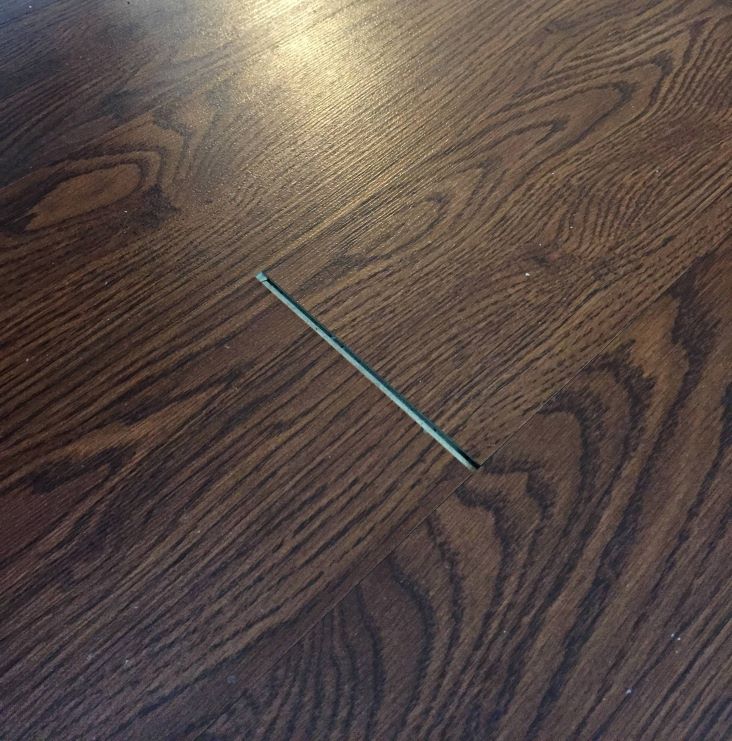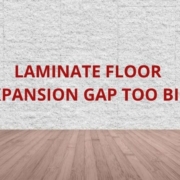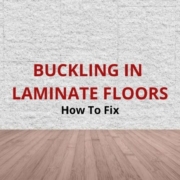How To Fix Laminate Flooring That Is Separating
The last thing you expect to happen when looking at your newly laid surface is to spot a few planks of your laminate floor coming apart. Especially if you were hoping to enjoy a gleaming expanse of wood-like flooring for the near foreseeable future without any hiccups..
So what steps would you need to take to resolve the issue? Find out all you need to know about how to fix laminate flooring that is separating, right here.

Why Are My Laminate Flooring Separating?
There are a number of reasons why gaps are appearing on your laminate floor. Some of the most common of them are:
Changes in temperature and humidity
Laminate flooring is affected by changes in temperature and humidity just like wood floors are. Laminate floors contract & expand as their values decrease and increase.
Ambient humidity levels should be maintained between 30 – 60 percent. If they fall outside these limits, your laminate flooring planks may start to separate.
Problems with interlocking
Laminate floor planks have a click and lock system. If they do not interlock properly, they may separate later on once the floor has been installed.
This issue is generally caused by the presence of debris in the groove system, or a faulty tongue or groove.
Failure to acclimatize flooring
Like wood flooring, laminate boards need to be acclimatized before being installed.
This can be done by leaving the flooring in its container in the room in which it is meant to be installed for a minimum of 48 hours.
Unprofessional installations
There are several issues a non-professional or first-timer may overlook when installing a laminate floor.
For example, they may not leave an expansion gap; they may also fail to notice that the subfloor is uneven, and is therefore unsuitable for having laminate flooring installed over it.
An uneven subfloor
Installing your laminate flooring over an uneven subfloor can actually affect the interlocking mechanism of the boards and cause them to separate, later on.
As a result, it is important for you to check the level of the subfloor before you begin the installation process.
How to Repair Separating Laminate Floors
Fixing laminate planks that are separating is a straightforward affair. Below we have provided the items you will need and the steps you will have to follow to reconnect laminate floors in order to close up any gaps.
Items you will need:
- Floor gap fixer
- Mallet
- Clear wood glue (optional)
- Putty (optional)
- 180 grit sanding paper (optional)
1. Clean the Gaps
Using a vacuum cleaner clean up any debris between the gaps you are about to fix and then wipe the planks clean with a damp cloth.
Doing so will eliminate any lingering dirt or particles which might prevent the boards from fitting together perfectly.
2. Apply the Floor Gap Fixer
Select the first plank you need to work on. You will need to ensure you work outwards away from the closest wall. (This is important since any outstanding gaps which remain once you have moved separated planks close to each other, will be closest to the wall where they will be less noticeable.)
Next, place the floor gap fixer one inch from the gap (ensure you have removed its adhesive strip first of all).
Using your mallet, give the end of the floor gap fixer a sharp tap until the gap between the two boards is closed completely.
You will need to ensure you maintain a firm grasp on the gap fixer during the process.
You may need to give a few taps before the board fits snugly against the one in front of it.
However, you should take special care not to strike the gap fixer too hard with the mallet.
3. Apply an Adhesive
You may also be able to add glue to the tongue and groove of the planks you intend to join using a cotton swab or a toothpick. You will need to promptly push the boards together, and wipe away any excess glue.
Alternatively, you will also be able to use putty in place of glue. However, you will need to sand it down with sandpaper (at least 180 grit) once it is dry.
Using an adhesive is optional but can serve to decrease the likelihood of any gaps reoccurring in the future.

How to Keep Laminate Floors From Separating
There are a number of precautions you can take to ensure your surfaces will remain in excellent condition once they have been installed. Below, we examine what they are and how to keep your laminate floors from separating.
Regulate humidity levels
Humidity levels should be monitored carefully ensuring they do not fall outside the range of 35 – 55%.
Hygrometers are particularly useful instruments for measuring these values.
It is also important for you to ensure that you use dehumidifiers during warmer summer months when humidity levels are likely to rise (air conditioning can also help as well since it has a similar effect).
During colder months when humidity levels tend to fall, you may need to use a humidifier instead to prevent them from falling and your floors from shrinking as a result.
Ensure proper installation
Although laminate flooring is comparatively easy to install, special care must be taken to ensure the appropriate steps are followed in each instance.
This is because different manufacturers provide varying tongue and groove systems (for example, certain varieties of laminate flooring can be installed without the use of a mallet). Failing to follow the correct procedure might not only damage the planks and possibly result in gaps, but also void your warranty.
It is possible to order sample boards and practice with them. Doing so can enable you to get the hang of working with your flooring efficiently and decrease the likelihood of any possible hiccups occurring during the installation process.
Acclimatize your flooring
During the manufacturing and storage process, your laminate flooring would have gotten exposed to varying levels of temperature and humidity.
Acclimatizing it will enable it to become accustomed to the ambient humidity and temperature in your home.
Generally, laminate flooring should be left in its original packaging on the floor of the room in which it is meant to be installed.
The process usually lasts for a maximum of three days (and a minimum of two), unlike solid hardwood flooring which can take as long as one week.
Failing to acclimatize your laminate flooring may result in your warranty being voided.
Enlist the services of a professional
Although laminate flooring is pretty easy to install, getting a professional can turn out to be beneficial in the long run. Especially if you are unacquainted with the procedure yourself.
A professional will be more skilled at cutting boards to fit irregular shapes and laying diagonal flooring, for example.
Examine your subfloor before installation
Before installing your laminate flooring, you will need to ensure that the available subfloor is appropriate for it and is in excellent condition.
Subfloors of carpet or glued vinyl, for example, are unsuitable for laminate flooring, while concrete, plywood, or tile, on the other hand, are ideal options for surfaces in this category.
It is also important for the subfloor to be level. Irregular subfloors can be made so by the use of self-leveling compounds or a floor grinder or sander. The services of a professional may be required if the structure happens to have more than a few irregularities.
Conclusion
Gaps in laminate flooring can easily be rectified by means of a straightforward, inexpensive procedure.
However, care should be taken to work towards the center of the room to ensure any outstanding gaps end up closest to the wall where they will be least noticeable.
Taking the appropriate preventative measures before installing your flooring, such as ensuring the subfloor is of a suitable material and is level can significantly lower the likelihood of gaps occurring.
Table of Contents







